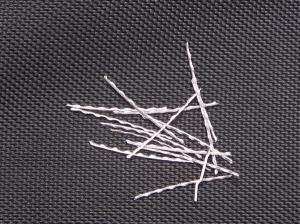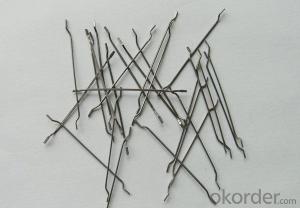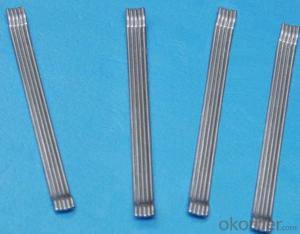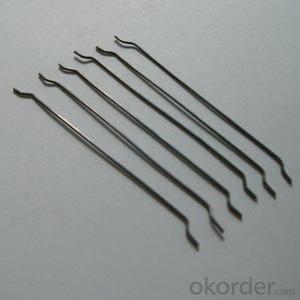Melt Extract Stainless Steel Fiber Straight Type China from CNBM
- Loading Port:
- Tianjin
- Payment Terms:
- TT OR LC
- Min Order Qty:
- 1000 kg
- Supply Capability:
- 30000 kg/month
OKorder Service Pledge
OKorder Financial Service
You Might Also Like
Quick Details
Place of Origin: Jiangsu, China (Mainland)
Model Number: HT-ST
Material: Steel
Specifications
steel fiber reinforced refractory : Easy to stirb. Evenly dispersedc. Decentralized energy and reduce stress concentration
Such steel fiber using the technology into a row of single steel fiber bonding with water-soluble glue, to ensure that the steel fiber uniformly dispersed in concret, easily stirred, eliminate agglomerate phenomena such as, due to the bonding of steel fiberrows technology, steel fibers in concrete can be evenly distributed, so that the concrete structure by the impact of steel fibers can absorb impact energy, reduce stress concentration, effectively control the emergence and development of cracks in the concrete, to extend the structural life.
As reliable and efficient concrete reinforcement material, it is widely uesd in buildings, bridges, thin roof engineering, highway etc.
In bonding steel fiber concrete internal steel fiber, as long as ramming close-grained, and air separation, steel fiber generally don't happen corrosion phenomena. Dew in the concrete surface or in the crack width more than 0.25 mm, jumper cracks in the steel fiber, vulnerable to corrosion phenomena.
Picture

Steel fiber straight type


FAQ
certificated: ISO 9001
Technical advantages of Daye steel fiber:
A. Improve mechanical performance of concrete
B. Provide uniform distribution throughout concrete with excellent mixing
C. No balling or caking by adopt correct mixing method
D. Reduce concrete volume
E.Save construction time and cost
F.Reduce excavation volume
G.Available for jointless floor.
- Q: What is the effect of melt extract stainless steel fiber on the dimensional stability of concrete?
- The use of melt extract stainless steel fiber in concrete has a significant effect on the dimensional stability of the material. These fibers are added to the concrete mixture during the mixing process, where they are evenly dispersed throughout the mixture. One of the main benefits of melt extract stainless steel fiber is its ability to enhance the overall strength and durability of concrete. The fibers act as reinforcement, providing additional tensile strength to the material. This reinforcement helps to prevent cracking and shrinkage, which are common issues in concrete structures. By reducing cracking and shrinkage, melt extract stainless steel fiber improves the dimensional stability of concrete. This means that the concrete maintains its original shape and size over time, even under varying environmental conditions such as temperature changes or moisture exposure. The addition of these fibers also improves the overall performance of the concrete in terms of resistance to impact, abrasion, and fatigue. This makes it particularly useful in applications where the concrete will be subjected to heavy loads or frequent wear and tear. Furthermore, melt extract stainless steel fiber can also enhance the fire resistance of concrete. The fibers have a high melting point, which helps to slow down the spread of fire and prevent structural collapse. This is especially important in buildings and structures where fire safety is a concern. Overall, the use of melt extract stainless steel fiber in concrete greatly improves its dimensional stability, strength, and durability. This leads to longer-lasting, more reliable concrete structures that are better able to withstand various environmental and mechanical forces.
- Q: How does melt extract stainless steel fiber affect the shrinkage and cracking of concrete?
- Melt extract stainless steel fiber can have a significant impact on the shrinkage and cracking of concrete. When added to concrete mixtures, these fibers help to control and reduce the shrinkage of the concrete during the drying and curing process. Shrinkage is a natural occurrence in concrete as it loses moisture and undergoes hydration. This shrinkage can result in cracks appearing on the surface of the concrete, compromising its integrity and durability. However, the addition of stainless steel fibers can help mitigate these issues. The stainless steel fibers act as reinforcement within the concrete matrix, providing increased tensile strength and improved ductility. This reinforcement helps to distribute the stress and strain that occurs during shrinkage, reducing the likelihood of cracks forming. Furthermore, the presence of stainless steel fibers in the concrete can also enhance its resistance to plastic shrinkage cracking. Plastic shrinkage occurs when water is lost from the concrete surface at a faster rate than it can be replaced, resulting in cracks. The fibers help to bridge any cracks that may occur, preventing them from propagating and ultimately reducing the overall cracking potential. Additionally, stainless steel fibers can also improve the overall durability of the concrete by enhancing its resistance to impact, fatigue, and abrasion. This can result in a longer service life and reduced maintenance needs for structures constructed with concrete containing these fibers. In summary, melt extract stainless steel fibers can positively impact the shrinkage and cracking of concrete by providing reinforcement and enhancing its overall durability. By controlling shrinkage and mitigating the risk of cracking, these fibers contribute to the long-term performance and structural integrity of concrete structures.
- Q: What is the effect of melt extract stainless steel fiber on the plastic settlement of shotcrete?
- The effect of melt extract stainless steel fiber on the plastic settlement of shotcrete is significant. The addition of melt extract stainless steel fibers to shotcrete helps to improve its overall performance and reduce plastic settlement. Shotcrete is commonly used in construction for its ability to be applied quickly and efficiently. However, one of the challenges with shotcrete is plastic settlement, which refers to the settling or sinking of the material before it sets and hardens. This settlement can lead to cracks, voids, and reduced strength in the shotcrete. Melt extract stainless steel fibers are specifically designed to address this issue. These fibers are added to the shotcrete mix, and during the application process, they disperse uniformly throughout the material. As the shotcrete settles, the stainless steel fibers act as reinforcement, providing additional support and preventing excessive settlement. The stainless steel fibers enhance the tensile strength of the shotcrete, making it more resistant to cracking and deformation. They create a three-dimensional network within the material, increasing its overall structural integrity. This reinforcement effect significantly reduces the plastic settlement of shotcrete, ensuring that it retains its shape and strength during the setting process. Furthermore, melt extract stainless steel fibers also improve the durability and longevity of shotcrete. They help to prevent the formation of shrinkage cracks and provide added protection against external factors such as temperature changes, moisture, and chemical exposure. In summary, the addition of melt extract stainless steel fibers to shotcrete has a positive effect on its plastic settlement. These fibers reinforce the material, reduce settlement, and improve its overall performance, durability, and strength.
- Q: Steel fiber prices? (recent price)
- The main varieties of steel fiber are steel plate shearing type, steel wire cutting type and Steel Ingot Milling type. At present, shear steel fiber is the main application of steel fiber reinforced concrete in china.
- Q: Can melt extract stainless steel fiber be used in lightweight concrete?
- Melt extract stainless steel fiber is capable of being utilized in lightweight concrete, thereby enhancing its mechanical attributes. The incorporation of stainless steel fiber into concrete serves to augment its tensile strength, flexural strength, and impact resistance. Conversely, lightweight concrete is a concrete variant that integrates lightweight aggregates or foaming agents in order to decrease its density and enhance its thermal and acoustic characteristics. The addition of melt extract stainless steel fiber to lightweight concrete offers supplementary reinforcement and improves its performance. The stainless steel fibers facilitate the even distribution of stresses throughout the concrete matrix, thereby bolstering its resistance to cracking and strengthening its overall durability. Furthermore, the use of stainless steel fibers can heighten the ductility of lightweight concrete, enabling it to better withstand dynamic loads and mitigate the possibility of sudden failure. To summarize, melt extract stainless steel fiber represents a suitable choice for reinforcing lightweight concrete due to its ability to enhance its mechanical properties and bolster its durability.
- Q: What is the impact of melt extract stainless steel fiber on the thermal properties of concrete?
- The thermal properties of concrete are greatly impacted by the presence of melt extract stainless steel fiber. To enhance the concrete's thermal conductivity and heat resistance, stainless steel fibers are incorporated into the concrete mixture. These fibers serve as conduits for heat within the concrete structure, enabling better heat transfer throughout the entire building. By adding stainless steel fibers, the thermal conductivity of concrete is increased, resulting in more efficient heat transfer within the material. This is particularly advantageous in situations where effective heat dissipation is crucial, such as in the construction of high-temperature industrial facilities or fire-resistant structures. Additionally, the inclusion of stainless steel fibers helps mitigate the risk of thermal cracking in concrete. When exposed to high temperatures, concrete undergoes thermal expansion, which can lead to the formation of cracks. However, by incorporating stainless steel fibers, the heat is distributed more evenly throughout the concrete, reducing the likelihood of localized thermal stresses and consequent cracking. Moreover, stainless steel fibers contribute to enhancing the fire resistance of concrete. By reinforcing the concrete and preventing the propagation of cracks and spalling caused by thermal shock during a fire, the addition of these fibers improves the overall fire rating of concrete structures. In conclusion, the incorporation of melt extract stainless steel fibers in concrete has a significant impact on its thermal properties. It enhances thermal conductivity, reduces the risk of thermal cracking, and increases fire resistance. These advantages make stainless steel fiber-reinforced concrete the preferred choice for applications where thermal performance and resistance to high temperatures are of utmost importance.
- Q: Can melt extract stainless steel fiber be used in architectural precast concrete applications?
- Yes, melt extract stainless steel fiber can be used in architectural precast concrete applications. This type of fiber enhances the strength, durability, and crack resistance of the concrete, making it suitable for architectural precast projects.
- Q: How does melt extract stainless steel fiber enhance the flexural strength of concrete?
- Melt extract stainless steel fiber enhances the flexural strength of concrete by improving its resistance to cracking and increasing its overall durability. The fibers act as reinforcement, distributing stress and absorbing energy that would otherwise cause the concrete to fail under bending or flexural loads. This reinforcement helps to resist the formation and propagation of cracks, leading to greater flexural strength and improved performance of the concrete structure.
- Q: What is the effect of melt extract stainless steel fiber on the carbonation resistance of concrete?
- The carbonation resistance of concrete is positively affected by the utilization of melt extract stainless steel fiber. Stainless steel fibers, renowned for their high corrosion resistance, play a crucial role in safeguarding the concrete against carbonation. Carbonation occurs when carbon dioxide from the atmosphere reacts with the calcium hydroxide present in the concrete, resulting in the formation of calcium carbonate. This chemical reaction can lower the pH level within the concrete, rendering it more susceptible to corrosion of the reinforcing steel. By incorporating melt extract stainless steel fibers into the concrete mixture, the risk of carbonation is significantly mitigated. These fibers act as a physical barrier, effectively preventing carbon dioxide from permeating the concrete. This, in turn, helps maintain a higher pH level within the material, thereby safeguarding the reinforcing steel and enhancing the overall durability of the concrete structure. Moreover, the utilization of stainless steel fibers enhances the mechanical properties of the concrete, including its tensile strength and flexural strength. This further fortifies the material's resistance to carbonation and other environmental factors. To summarize, the addition of melt extract stainless steel fibers profoundly enhances the carbonation resistance of concrete. As a result, concrete structures benefit from increased durability, reduced maintenance requirements, and an extended service life.
- Q: Can melt extract stainless steel fiber be used in seismic-resistant concrete applications?
- Yes, melt extract stainless steel fiber can be used in seismic-resistant concrete applications. Stainless steel fibers are commonly used as reinforcement in concrete to enhance its strength, durability, and ductility. In seismic-resistant concrete applications, stainless steel fibers help to improve the concrete's resistance to cracking and enhance its ability to withstand the dynamic forces generated during an earthquake. The melt extract stainless steel fibers are particularly suitable for such applications due to their high tensile strength, corrosion resistance, and ability to disperse uniformly within the concrete matrix. They effectively reinforce the concrete and provide enhanced crack control, reducing the risk of structural failure during seismic events. Therefore, using melt extract stainless steel fiber in seismic-resistant concrete can significantly improve the overall performance and safety of the structure.
Send your message to us
Melt Extract Stainless Steel Fiber Straight Type China from CNBM
- Loading Port:
- Tianjin
- Payment Terms:
- TT OR LC
- Min Order Qty:
- 1000 kg
- Supply Capability:
- 30000 kg/month
OKorder Service Pledge
OKorder Financial Service
Similar products
Hot products
Hot Searches
Related keywords



























